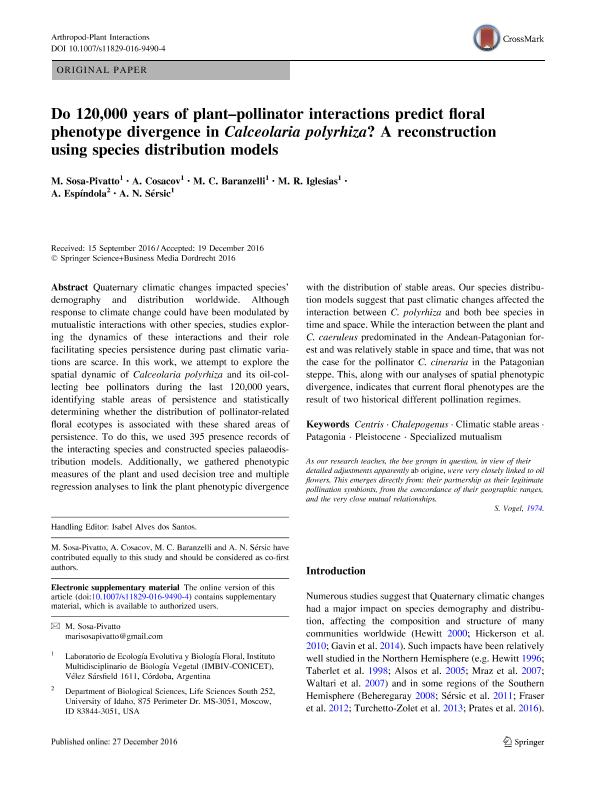Mostrar el registro sencillo del ítem
dc.contributor.author
Sosa Pivatto, María Susana

dc.contributor.author
Cosacov Martinez, Andrea

dc.contributor.author
Baranzelli, Matias Cristian

dc.contributor.author
Iglesias, María del Rosario

dc.contributor.author
Espíndola, Anahí
dc.contributor.author
Sersic, Alicia Noemi

dc.date.available
2017-09-14T17:58:08Z
dc.date.issued
2016-12
dc.identifier.citation
Sosa Pivatto, María Susana; Cosacov Martinez, Andrea; Baranzelli, Matias Cristian; Iglesias, María del Rosario; Espíndola, Anahí; et al.; Do 120,000 years of plant–pollinator interactions predict floral phenotype divergence in Calceolaria polyrhiza? A reconstruction using species distribution models; Springer; Arthropod-plant Interactions; 11; 3; 12-2016; 351-361
dc.identifier.issn
1872-8855
dc.identifier.uri
http://hdl.handle.net/11336/24250
dc.description.abstract
Quaternary climatic changes impacted species demography and distribution worldwide. Although response to climate change could have been modulated by mutualistic interactions with other species, studies exploring the dynamics of these interactions and their role facilitating species persistence during past climatic variations are scarce. In this work, we attempt to explore the spatial dynamic of Calceolaria polyrhiza and its oil-collecting bee pollinators during the last 120,000 years, identifying stable areas of persistence, and statistically determining if the distribution of pollinator related floral ecotypes is associated with these shared areas of persistence. To do this, we used 395 presence records of the interacting species and constructed species palaeodistribution models. Additionally, we gathered phenotypic measures of the plant and used Decision Tree and multiple regression analyses to link the plant phenotypic divergence with the distribution of stable areas. Our species distribution models suggest that past climatic changes affected the interaction between C. polyrhiza and both bee species in time and space. While the interaction between the plant and C. caeruleus predominated in the Andean-Patagonian forest and was relatively stable in space and time that was not the case for the pollinator C. cineraria in the Patagonian Steppe. This, along with our analyses of spatial phenotypic divergence, indicates that current floral phenotypes are the result of two historical different pollination regimes.
dc.format
application/pdf
dc.language.iso
eng
dc.publisher
Springer

dc.rights
info:eu-repo/semantics/openAccess
dc.rights.uri
https://creativecommons.org/licenses/by-nc-sa/2.5/ar/
dc.subject
Centris
dc.subject
Chalepogenus
dc.subject
Climatic Stable Areas
dc.subject
Patagonia
dc.subject
Pleistocene
dc.subject
Specialized Mutualism
dc.subject.classification
Bioquímica y Biología Molecular

dc.subject.classification
Ciencias Biológicas

dc.subject.classification
CIENCIAS NATURALES Y EXACTAS

dc.title
Do 120,000 years of plant–pollinator interactions predict floral phenotype divergence in Calceolaria polyrhiza? A reconstruction using species distribution models
dc.type
info:eu-repo/semantics/article
dc.type
info:ar-repo/semantics/artículo
dc.type
info:eu-repo/semantics/publishedVersion
dc.date.updated
2017-09-01T17:59:23Z
dc.identifier.eissn
1872-8847
dc.journal.volume
11
dc.journal.number
3
dc.journal.pagination
351-361
dc.journal.pais
Países Bajos

dc.journal.ciudad
Dordrecht
dc.description.fil
Fil: Sosa Pivatto, María Susana. Consejo Nacional de Investigaciones Científicas y Técnicas. Centro Científico Tecnológico Conicet - Córdoba. Instituto Multidisciplinario de Biología Vegetal. Universidad Nacional de Córdoba. Facultad de Ciencias Exactas Físicas y Naturales. Instituto Multidisciplinario de Biología Vegetal; Argentina
dc.description.fil
Fil: Cosacov Martinez, Andrea. Consejo Nacional de Investigaciones Científicas y Técnicas. Centro Científico Tecnológico Conicet - Córdoba. Instituto Multidisciplinario de Biología Vegetal. Universidad Nacional de Córdoba. Facultad de Ciencias Exactas Físicas y Naturales. Instituto Multidisciplinario de Biología Vegetal; Argentina
dc.description.fil
Fil: Baranzelli, Matias Cristian. Consejo Nacional de Investigaciones Científicas y Técnicas. Centro Científico Tecnológico Conicet - Córdoba. Instituto Multidisciplinario de Biología Vegetal. Universidad Nacional de Córdoba. Facultad de Ciencias Exactas Físicas y Naturales. Instituto Multidisciplinario de Biología Vegetal; Argentina
dc.description.fil
Fil: Iglesias, María del Rosario. Consejo Nacional de Investigaciones Científicas y Técnicas. Centro Científico Tecnológico Conicet - Córdoba. Instituto Multidisciplinario de Biología Vegetal. Universidad Nacional de Córdoba. Facultad de Ciencias Exactas Físicas y Naturales. Instituto Multidisciplinario de Biología Vegetal; Argentina
dc.description.fil
Fil: Espíndola, Anahí. University Of Idaho; Estados Unidos
dc.description.fil
Fil: Sersic, Alicia Noemi. Consejo Nacional de Investigaciones Científicas y Técnicas. Centro Científico Tecnológico Conicet - Córdoba. Instituto Multidisciplinario de Biología Vegetal. Universidad Nacional de Córdoba. Facultad de Ciencias Exactas Físicas y Naturales. Instituto Multidisciplinario de Biología Vegetal; Argentina
dc.journal.title
Arthropod-plant Interactions

dc.relation.alternativeid
info:eu-repo/semantics/altIdentifier/url/https://link.springer.com/article/10.1007/s11829-016-9490-4
dc.relation.alternativeid
info:eu-repo/semantics/altIdentifier/doi/http://dx.doi.org/10.1007/s11829-016-9490-4
Archivos asociados
